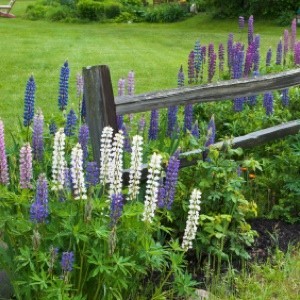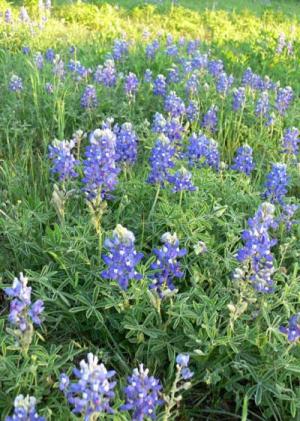
Have you ever gathered seeds from wild lupine plants to sow in your garden and ended up with disappointing results? Stands of lupine are easy to establish this way, providing the conditions are right. Here are some tips for sowing and growing wild lupine that will increase your chances of achieving success.
Distribution: In Canada, wild lupine occurs in Ontario and Newfoundland. In the United States, its natural distribution extends from Minnesota and Iowa eastward through the Great Lakes and New England south through Kentucky, West Virginia, and the Atlantic coast states to northern Florida and eastern Texas. (Source, USDA Forest Service)
Appearance: Lupine grows from 8 to 24 inches tall. Plants feature 7 to 11 dark green palmate leaves, and eighteen-inch spikes of flowers that vary in color from white to pink to shades of dark violet-blue.
Reproduction & life cycle: Lupine are perennial members of the legume family. (Like other legumes, lupine are nitrogen fixers-they actually increase the amount of nitrogen in the soil where they grow.) Individual plants can be short-lived or long-lived, depending on environmental conditions. Reproduction is by seeds or rhizomes. Each adult plant is capable of producing dozens of pods that hold several hundred seeds each.
Germination & flowering: Lupine germinate in late March to mid-April and produce blooms their second year of growth that flower annually from May to June.
Ecological importance: Lupine are the only larval food source of the federally endangered Karner blue butterfly. They are also visited by honey bees, bumble bees, eastern carpenter bees, black swallowtail, clouded sulfur butterflies, and many other beneficial garden insects.
Toxicity: The foliage is said to be toxic to sheep and horses. Although typically ignored by wildlife, deer, rabbits, and woodchucks may occasionally browse on wild lupine.
Lupine will grow almost anywhere, but perform best in cooler climates. Lupine prefers full sun and grows best in sandy soils with a slightly acidic pH. In the wild, you can find them growing in dry, sandy openings such as those found in savannas, woodland clearings, or areas recently disturbed by grazing, logging, or fire.
Only a small percentage of wildflower seeds survive, so you'll need to gather and sow lots of them for best results. Never collect more than 30% of your lupine seed from a single area, and steer clear of areas known to support Karner blue butterflies. Instead of trying to gather enough seeds to establish a stand all at once, gather and plant seeds over the course of several years. Be a good steward. Always obtain permission from private landowners and check permit requirements before collecting seed on public land.
Collecting wild lupine seeds can be tricky. As seeds in the pod mature, the seed pod blackens and dries. When seeds are fully ripe, the pod splits open suddenly and launches the seed several feet away (up to 16 feet!). This process happens quickly-usually in early summer (late June or early July). The goal is to collect the pods when they are almost ripe--after they blacken but before they split open and launch their seeds. Plants growing in drier, sunnier areas, or on steep slopes tend to mature the earliest.
If you miss your first window of opportunity to gather seed pods, don't worry. You may get a second chance. The seeds in the lowest pods on the stalk ripen first. They usually burst open (or are eaten by insects) before those in the upper pods are ready.
To collect the seeds, cut off stalks containing several almost-ripe pods and put them into a large paper bag. Poke a few small holes in the bag to promote air circulation and store the bag in a cool, dry place. Make sure to staple the bag shut! ( I learned this the hard way.) As the pods continue to ripen in the bag, they will burst open with great force. If your bag isn't secured shut, you may lose a lot of your seeds, or at the very least, have a real mess to clean up. After about a week of letting them dry out and burst in the bag, you should be able to open it and discard the empty pods.
Lupine seed tends to grow best when planted in the late fall, before the ground freezes. In cooler zones, fall-planted, air-dried seed does not need to be cold-treated, nicked, or soaked in water before planting. It will germinate in the spring, when soil moisture is ideal and temperatures are just above freezing.
Randomly sprinkling seeds over a desired growing location is unlikely to give you good results. The seeds need to make good contact with the soil in order to take root and grow. You'll have much better luck if you lightly rake the area and press the seeds gently into the soil.
Seeds may germinate shortly after they are planted or remain dormant for several years. Because they have such hard seed coats, germination is often improved by soaking the seeds for 15 to 30 minutes in warm water, or nicking them lightly on the round side with a razor blade. In warmer zones, germination rates may also be improved by storing the seeds at near freezing temperatures for 6-8 weeks before sowing. Seedlings will bloom the second year. Once established, plants will self-sow.

About The Author: Ellen Brown is an environmental writer and photographer and the owner of Sustainable Media, an environmental media company that specializes in helping businesses and organizations promote eco-friendly products and services. Contact her on the web at http://www.sustainable-media.com
Add your voice! Click below to comment. ThriftyFun is powered by your wisdom!
Another form of lupine is the Texas bluebonnet but they are sown in the fall and bloom the next spring.
Water the area where you have sown them in the fall periodically and then if it gets very dry over the winter and spring.
Look at this photo so you can recognize the leaves. The plants will remain small until about a month before they bloom which is during March to May depending on your zone.

Couldn't resist posting this photo of my daughter several years ago in the native Texas bluebonnets. Another lovely form of lupine.

Add your voice! Click below to comment. ThriftyFun is powered by your wisdom!